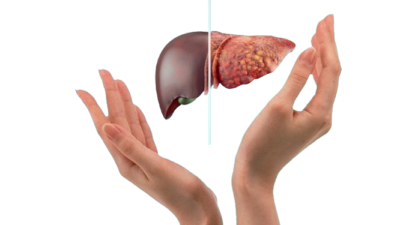What is Fatty Liver?
Fatty liver disease is a medical condition that is distinguished by the buildup of surplus fat within the cells of the liver. This condition can be broadly categorized into alcoholic fatty liver disease (AFLD), caused by excessive alcohol consumption, and non-alcoholic fatty liver disease (NAFLD), which is unrelated to alcohol intake. In NAFLD, risk factors include obesity, insulin resistance, type 2 diabetes, and metabolic syndrome.
This condition can be broadly categorized into alcoholic fatty liver disease (AFLD), caused by excessive alcohol consumption, and non-alcoholic fatty liver disease (NAFLD), which is unrelated to alcohol intake. In NAFLD, risk factors include obesity, insulin resistance, type 2 diabetes, and metabolic syndrome.
As fat accumulates in the liver, it may lead to inflammation and liver cell damage. While early stages of fatty liver disease may be asymptomatic, advanced cases can result in more severe symptoms, such as fatigue, abdominal pain, and, in extreme cases, may progress Conditions such as non-alcoholic steatohepatitis (NASH), cirrhosis, or liver failure are among the ailments that can arise. Lifestyle modifications, including a healthy diet, exercise, and weight management, are key components in the prevention and management of fatty liver disease. If left untreated, it can have serious implications for liver health and overall well-being.
Symptom of Fatty Liver
The symptoms can vary, and some individuals may not experience noticeable symptoms at all. Here is a detailed description of symptoms associated with fatty liver disease:
Asymptomatic (No Symptoms):
Fatty liver disease can be asymptomatic, meaning individuals may not experience any noticeable symptoms. In many cases, the condition is detected incidentally during routine medical tests or imaging studies.
Mild Symptoms:
Fatigue: Some individuals with fatty liver disease may experience fatigue or a general sense of tiredness.
Discomfort in the Upper Right Abdomen: Mild discomfort or a feeling of fullness in the upper right side of the abdomen may occur.
Advanced Symptoms (Inflammation and Scarring):
Persistent Fatigue: As the disease progresses, fatigue may become more pronounced.
Abdominal Pain: Ongoing discomfort or pain in the upper right abdomen may develop.
Unexplained Weight Loss: Some individuals may experience unintended weight loss.
Weakness: A sense of weakness or lack of energy.
Jaundice: In more severe cases, yellowing of the skin and eyes (jaundice) may occur due to impaired liver function.
Complications of Advanced Fatty Liver Disease:
Non-Alcoholic Steatohepatitis (NASH): This is a more severe form of NAFLD, characterized by inflammation and liver cell damage. Symptoms may become more pronounced, and the risk of progressing to cirrhosis increases.
Cirrhosis: In advanced stages, fatty liver disease can lead to cirrhosis, marked by scarring of the liver tissue. This can result in a range of symptoms, including abdominal swelling (ascites), confusion, and increased susceptibility to bleeding.
Liver Failure: Severe cases may lead to liver failure, a life-threatening condition requiring immediate medical attention.
It’s important to note that fatty liver disease is often associated with underlying conditions such as obesity, type 2 diabetes, insulin resistance, and metabolic syndrome. Lifestyle modifications, including a healthy diet, regular exercise, and weight management, are crucial in managing and preventing fatty liver disease. If you suspect you have symptoms of fatty liver disease, it’s essential to consult with a healthcare professional for a thorough evaluation and appropriate management.

